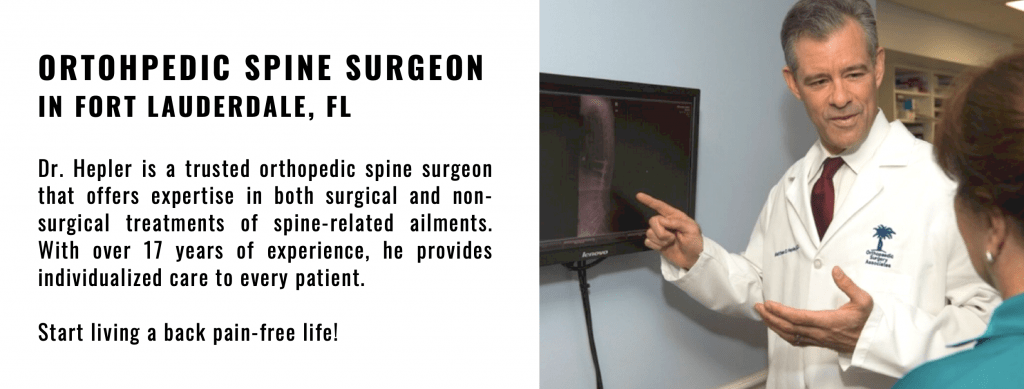10 things you didn’t know about scoliosis
Did you know that scoliosis is the most common deformity of the spine affecting children and adults? Don’t be alarmed! A scoliosis diagnosis doesn’t necessarily mean you’ll have to get back surgery; doctors can offer you a wide range of treatment options to help you manage your scoliosis symptoms without surgery. However, you should consider seeing a back specialist for advice on how to treat your spinal condition.
To help you understand the condition better, Dr. Hepler, a spine surgeon in Palm Beach County, presents 10 things you may not know about scoliosis:
1. Scoliosis is not a spinal disease but rather, an abnormality.
Scoliosis is a condition whereby the spine develops an abnormal curvature instead of a straight line. The spine of a person with scoliosis takes a shape similar to an S or C. It is common for patients to be born with scoliosis, but the abnormality can also be a result of physical trauma or other adult-onset degenerative condition. However, for most people with scoliosis, there is no identifiable cause or underlying condition. In such cases, the condition is called idiopathic scoliosis, which is the most common form.
2. Scoliosis usually begins in adolescence.
Over 80% of idiopathic scoliosis start in adolescence. While the exact reason behind this is not fully known, the physical growth and changes that happen quickly during adolescence are likely to blame. At this age, early scoliosis detection is important in order to keep it from going beyond a curve of 40 degrees.
3. More than half of people aged 60 and above have mild degenerative scoliosis.
While scoliosis mostly develops during adolescence, older adults can also get it. Because adult scoliosis does not often cause obvious symptoms, many people who have it are not aware of their condition. Furthermore, adult scoliosis progresses gradually. As a result, symptoms such as back ache and stiffness come and go.
4. It’s easy to miss scoliosis.
An official scoliosis diagnosis comes after the spine’s sideways curb called the Cobb angle, shows a curvature of 10 degrees or more. However, a curve of 10 to 20 degrees isn’t noticeable. Because of this, the scoliosis may continue to progress until it is in a more advanced state.
5. Early detection is key to keeping it from getting worse.
While scoliosis is incurable, early detection can significantly help keep it from getting worse. When detected during adolescence, spine doctors can recommend the best methods to manage it. These include physical therapy and exercises that can help strengthen the back muscles so they can provide ample support for the spine and reduce symptoms. This is why it is recommended to visit a spine specialist once parents and patients notice the early signs of scoliosis.
6. Surgery is not always necessary
As was mentioned above, there is only a small percentage of people with scoliosis where back surgery is required; if the curve is very big or growing very quickly, surgery might be recommended. It is preferential to treat it conservatively and with other treatment options, such as physical therapy. The best way to know which management and treatment solution is best for your condition is to consult an orthopedic spine surgeon.
7. Scoliosis cannot be prevented
Scoliosis is not caused by bad posture, carrying heavy backpacks, playing sports, or anything a child or parent did or did not do. Scoliosis is idiopathic, which means there is no known cause.
8. Giving up smoking is a proven treatment method
Did you know that smokers with scoliosis are at a much higher risk of progression of the condition as an adult? Smoking is the leading preventable cause of back and neck issues. If you quit smoking, you will not only decrease your scoliosis symptoms but also improve your overall health.
9. Scoliosis has no effect on conception
If you are a woman and have scoliosis, it does not mean you won’t be able to have children, or will have trouble with a natural birth. It should be stated that in most cases, women have no problems with pregnancy, so you can expect to have a safe and comfortable delivery.
10. You can return to sports after spinal surgery
When people hear “spine surgery,” they usually assume it means the end to any participation in recreational sports… but It doesn’t have to! After the appropriate recovery time, you’ll be able to take part in sports (including contact sports) again, just make sure to check with your doctor regarding your overall health before participating in any activities.
Need advice or consultation with a spine surgeon in Palm Beach County?
With more than 17 years of professional experience, Dr. Hepler is an adult and pediatric spine surgeon in Fort Lauderdale and Delray Beach. He treats all conditions of the cervical, thoracic and lumbar spine, and also provides spinal stenosis treatment in Delray Beach, and Boynton Beach. Additionally, he provides non-operative treatment options, such as pain medications, steroid injections, and physical therapy, as well as operative treatment, including both minimally invasive techniques and complex reconstruction.
If you or a loved one needs a spine health check or treatment, visit any of our locations:
Got any questions or would like to make an appointment? Don’t hesitate to Contact Us. We are here to make you stronger and healthier!
The material contained on this site is for informational purposes only and DOES NOT CONSTITUTE THE PROVIDING OF MEDICAL ADVICE, and is not intended to be a substitute for independent professional medical judgment, advice, diagnosis, or treatment. Always seek the advice of your physician or other qualified healthcare provider with any questions or concerns you may have regarding your health.




